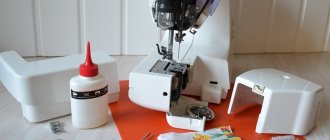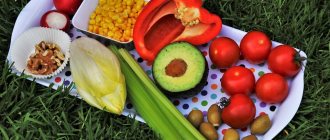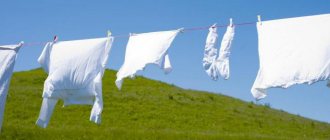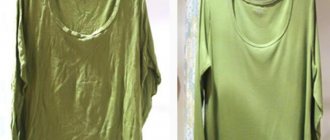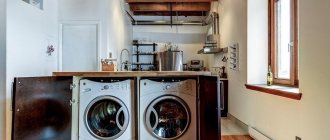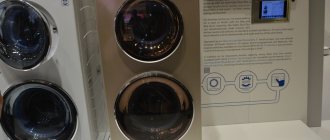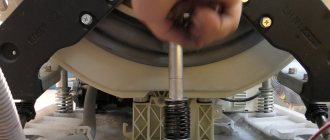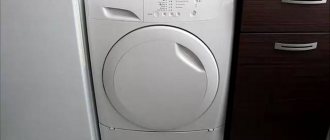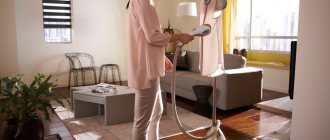Presser feet for basic operations
This category includes feet that can be used to make basic types of seams (straight stitch and zigzag), sew on a zipper or button, and process the edge of the material.
Universal zigzag foot
This foot is always included in the package. With its help, you can make both a straight stitch and a zigzag stitch of different widths. There are options with a special button for fixing the sole in a horizontal position. This feature will be useful when passing through areas with a sharp difference in fabric thickness, for example when crossing seams.
For straight stitch
Designed for even, straight stitches, which are helped by a small needle hole. This sole provides better quality stitching on sliding materials (for example, silk or satin).
For zipper
There are several types of feet that are designed for attaching zippers:
They can also be used for sewing on piping or stitching in difficult places.
For a blind seam
The special design of this foot is designed for working with thick fabrics and making invisible stitches on them. Most often used for hemming the bottoms of products (skirts, trousers, etc.). First, the part must be folded in a special way and a secret stitch must be selected on the machine.
Always perform a trial blindstitch on a sample of the fabric you are using to find the best settings for your job!
Overlock
This foot has a pressure plate and a guide, thanks to which the edge of the fabric is not pulled together and is leveled when sewing. There are models with a side knife that allow you to combine processing and trimming the seam allowance, just like an overlocker does.
For buttons
Using a sewing machine, you can quickly sew buttons with holes, the width between which should not exceed the maximum zigzag width of the machine. The special foot for this operation has rubberized linings for reliable fixation of the button. Sewing is done using a zigzag stitch and the lower feed is turned off.
For loops
The processing of the edges of the machine's slotted loop is carried out in 1 or 4 stages ( automatic or semi-automatic ) and different paws are needed for this. Special frames are available for automatic loops. They can have a loop length selected for a specific button, for which it is installed in the back of the frame and fixed. Additional markings are applied to the sides of the frames for semi-automatic hinges. Modern machines offer a touch loop function and, accordingly, a special foot.
For bias binding and hems
Processing products with bias tape or hemming a cut are frequently performed sewing operations. The feet for them are sometimes called “snails”, for the specially curved soles that bend the binding or the cut of the part is immediately stitched to the product. Available in different widths.
Types of sewing machine feet
There is a huge variety of auxiliary parts for sewing; it is impossible to list them all. The standard set usually includes a limited list of elements that are not enough for experienced users. On the other hand, you can easily find the necessary accessories separately, depending on the wishes and preferences of the needlewoman.
Healthy! The list of attachments included with the sewing machine and the rules for their operation are given in the user manual included with the equipment.
Universal
This model should be in the arsenal of every seamstress. It is designed to perform most sewing operations. The part has a special slot that allows you to make zigzag seams up to 7 mm wide. Some examples are equipped with a button that helps align the stroke when working with thick fabrics.
A universal model is necessary for every craftswoman
For zigzag
Used along with a universal tool. Suitable for creating both straight and zigzag seams. It is convenient because it makes it possible to process any types of materials.
Interesting! Experienced needlewomen prefer this type to obtain straight stitches, since it is more convenient than the universal one.
Zigzag foot
For overcasting edges
The design of such products includes a knife, which, when processing the fabric, first trims it and then aligns the edge for further overcasting. In this case, you need to ensure that during manipulation the edge fits tightly to the guide foot. The clamping element is sold complete with the overlock machine.
Edge stitching foot with fabric trimming knife
For straight stitch
Provides a perfectly even seam due to the placement of the needle strictly in the center of the part. Designed for materials that are difficult to process and often “move out” when sewing, such as satin, chiffon, silk.
Straight stitch foot
For zipper, for hidden zipper
These models come in different types and sizes. Usually the seamstress selects the one that is more suitable for herself individually - some prefer large and reliable ones, others prefer miniature ones. In any case, a product for sewing in a regular zipper will greatly facilitate and speed up the process, ensuring an excellent result without unnecessary hassle.
The accessory for a hidden zipper differs in design and purpose. It solves the main problem that arises when sewing on this decorative element. The resulting thickening on the material complicates further manipulations. Such an element is made with a special recess through which lightning passes freely and does not impede the process.
Zipper foot Invisible zipper attachment
Important! Working with a foot for a hidden zipper requires certain skills from the craftswoman. To achieve a high-quality result, it is better to practice on a rough patch at first.
For a blind seam
Allows you to create invisible stitches, which may be necessary for certain fabrics or designs. Usually equipped with a special guide. When working, you should set the desired type of seam and stitch frequency, after which you need to check the result on a small piece of fabric. This type of tool is suitable for thick and loose materials; on thin materials, the stitch mark will remain noticeable.
Blind hem foot
For cords and tucks
The products are presented in a separate model range. The parts for making tucks are distinguished by the presence of special protrusions on the sole, ensuring perfectly even straight lines. This design allows you to solve several problems:
- Collect fabric with pintucks of various shapes thanks to attachments of various configurations;
- Make straight lines that will be located strictly parallel to each other;
- Sew on laces to obtain the desired decorative images on clothing and interior items.
Hemming of cords can also be done with an attachment designed specifically for this purpose. It has special holes for the passage of rope. This accessory is considered more convenient and effective, but solves only one specific problem.
Foot for cords and tucks
Knitted foot
Suitable for delicate fabrics that require careful handling. With its help, you can easily process stretchy and thin fabrics without the fear of sagging and missed stitches. The nozzle is equipped with a rubber pad on the sole, which prevents possible unpleasant consequences. It is recommended to carry out manipulations at low speed to achieve high-quality results.
Knitting foot
For buttons
A very convenient item designed for quick and easy sewing on buttons. You just need to set the correct zigzag width, install the darning plate or turn off the lower conveyor (depending on the sewing machine model) and select the optimal place for sewing on the decorative element.
Button foot
Recommendation! To prevent the button from moving out of place, you can use specialized temporary glue.
Overlock foot
Designed for decorative processing of product cuts. Instances are equipped with a brush, which allows you to make even more even and beautiful stitches. The accessory significantly expands the capabilities of the machine.
Overlock foot
Walking
Designed to create perfectly straight seams with uniform spacing on thick, rough fabrics. With such an assistant it is easy to update an old blanket or quilt a heavy blanket. The included guide will help you achieve excellent results.
Upper feed or walking foot
For bias tape
Bias tape is very difficult to sew on; it is not so easy to achieve uniform placement of the material on both sides. Thanks to this element, it will not be difficult to cope with the task. The piece grabs the binding from above and below, pulling it over the edge of the fabric. Thus, it is attached evenly; you just need to carefully guide the blade through the tool.
Bias foot
To sew parallel lines
The design of the part ensures the uniform creation of two straight seams without much effort. Can come with or without a guide.
Parallel stitch foot Parallel stitch
Interesting! In addition, there is a wide variety of feet designed for creating unusual beautiful elements on clothes - fringe, threads of beads, beads or sequins, circular patterns and so on.
For decorative works
Using a sewing machine, you can not only sew together parts of a product, but also decorate the model with ruffles, cords, embroidery and other techniques.
For decorative stitches
The name “for satin” or “satin” stitches is also used. The sole has a wide open space and is often made of clear plastic, allowing you to see all the stitching and markings. Sliding plates smooth the thread, providing a “satin” surface.
For gathers and folds
In combination with the increased tension of the upper thread, this foot allows for uniform shirring of the part. You can immediately sew the frill to another, even fabric. There are also special devices for folds that allow you to set the exact value of the interval and depth.
For attaching cords and piping
These feet have a groove into which a finishing cord or thick decorative thread is inserted. Used for finishing clothing and accessories, interior textiles. Available for one, three, five or seven cords (depending on the manufacturer), it can also be designed for cords of different diameters.
For tucks
The sole with parallel grooves allows you to make neat pintucks on thin fabrics (up to 9 pieces, depending on the model). An additional plastic “tab” that is fixed to the needle plate will help create a more embossed finish.
For ribbons, rubber bands
The special design of the sole has a hole in front for braid or elastic of different widths, so that the finishing is evenly fed under the needle. Options with a wide slot are suitable for working in the chenille technique.
For beads and beads
Transparent feet with a groove are designed for attaching threads of beads, pearls and other beads. Designed for a specific diameter indicated in the description.
For fringe
In the middle of the sole there is a protrusion, due to which voluminous loops are formed when sewing. After completing the stitching, they are cut to form a fringe. Also suitable for making copy stitches.
For embroidery
These presser feet typically have a ring-shaped sole and are often made of clear plastic with an open front to allow maximum stitch visibility. The design of many models includes a spring. They can also be used for free stitching or darning.
For quilting
Patchwork feet can be divided into two groups:
- for grinding parts;
- for quilting the assembled fabric.
In this technique, it is especially important to sew all parts with the same width of seam allowance, which, according to tradition, is ¼ inch. Therefore, patchwork feet are made with this width of one or two halves. They can have a built-in guide and be transparent.
For quilting, spring feet are used in the form of a ring, sometimes with an open front. The guide can be installed separately or built-in. An overhead feed is often installed for this purpose, and Bernina has developed a special BSR foot that allows you to adjust the stitch length as you work for maximum accuracy when sewing multi-layered items.
We need different paws!
When your machine has a universal foot and you need to sew a finishing stitch, you can use the markings on the metal plate as a guide. Look, here are the numbers. They mean at what distance in centimeters from the needle the line will go. Apply the fold or cut to the 1.5 centimeter mark, make sure that the fold touches this mark during the sewing process, and your finishing stitch will pass at a distance of 1.5 centimeters.
A foot for sewing a hidden zipper, suitable for laying an even finishing stitch close to the fold. We install the foot, align the fold of our part with it, we get a finishing stitch 2 mm from the edge of the part. Suitable for cuffs, collars and trims.
A foot with a limiter and a foot with markings. It is easy to navigate by the divisions on the foot and make a stitch at the required distance.
This stopper foot holds the fold and can easily be used to topstitch close to the edge or add a reinforcement stitch into a split seam, such as along the waistband of a skirt.
More useful information on our FREE sewing webinars.
Presser feet for special materials
We will put into a separate category devices that make it easier to sew difficult materials, such as elastic ones or those with a slippery surface.
Please note that to achieve high quality stitching you will also need appropriate needles and threads.
Upper conveyor
You can often find the name “walking foot”. Designed for multi-layer projects, stitches, suitable for sewing finicky materials. As the name suggests, the main task of the upper conveyor is to “duplicate” the work of the lower conveyor. Thus, uniform advancement of the material on both sides is achieved. Can be produced with a guide and replaceable soles.
Teflon and roller
Two types of feet for working with leather, vinyl and similar materials that are difficult to move. The Teflon foot sole is made of special sliding plastic, and the roller foot facilitates advancement due to torque.
For knitwear
This design includes a special stop, and sometimes a silicone pad, due to which it is possible to avoid elastic material from getting into the teeth of the lower conveyor. The presser foot requires proper installation, with the long lever inserted behind the needle bar.
To change the presser foot you only need to replace the sole
With modern machines, you do not need to unscrew the screw securing the foot with a screwdriver to replace it. By lightly pressing the lever (behind the foot), the sole of the foot is detached. The new sole is fixed by lowering the presser foot rod into the sole socket. You should hear a characteristic click, but just in case, lift the presser foot lever up. If the sole is fastened securely, it will rise up too.
The most “popular” foot is the zigzag foot. With the help of this foot, many seamstresses perform almost all operations and even sew buttonholes automatically. Such skill is commendable, but the use of special paws will not only make your work easier, but will also increase its quality and the speed of the operation.
Below we post photos of presser feet designed for Janome sewing machines. The photo clearly shows the purpose of each foot and the sewing operation for which it is intended. Photos of the paws and their descriptions were taken from the site Elfort.ru.
Satin stitch foot, designed for working with figured stitches.
With this foot you can sew on beads quickly and accurately.
Bouclé foot. The formation of boucle on the surface of the fabric is ensured by the structure of the foot itself.
The zipper foot is universal.
Hemming foot 2mm.
The foot is for sewing on flat buttons only, please pay attention to this. Buttons with stems are sewn on by hand. See How to sew on a button correctly.
Video on how to sew a button on a sewing machine using a special foot.
With this foot you can make gathers on fabric or adjust braid with a gathered effect.
Foot for sewing on cord.
Foot for sewing several cords at the same time.
With this foot you can do embroidery (by moving the fabric with your hands), as well as figure stitching and basting.
Edging foot.
Overlock foot wide (C). It is intended for processing cuts and for decorative finishing of product cuts.
Automatic buttonhole foot. See also Features of making loops in semi-automatic mode.
The blindstitch foot is used only for loose and thick fabrics. On thin fabrics the stitch mark will be visible.
Watch the video on how to use this foot.
Straight stitch foot.
You will need a roller foot when sewing leather, knitted fabrics, etc. See also Working with natural leather.
A Teflon foot is indispensable when sewing leather, suede, nubuck, etc.
Machine embroidery foot.
Photos of feet designed for Janome sewing machines were taken from the Elfort.ru website in the article Janome sewing feet.
Tools for working with leather To work with natural leather, you need special tools, devices for installing accessories, adhesives and other applied materials.
How to replace and sharpen overlock knives If the overlocker does not cut the fabric well, then you need to sharpen its knives. How to remove and install overlock knives and whether you can sharpen them yourself.
Knife for cutting fabric What is the difference between a round knife for cutting fabric and tailor's scissors? How to use OLFA circular knives, sharpen the blade, etc.
Reviews from a master about sewing machines This article contains reviews from a master adjuster about some modern and old models of sewing machines.
Sewing machine for leather Special industrial machines are designed for sewing leather. About which household sewing machine you can use to sew leather at home.
Singer sewing machine from the 90s In this article, the master will share his opinion about the models of Singer sewing machines produced in the early 90s.
Installing buttons and blocks on clothes To help you correctly install buttons and blocks on clothes with your own hands, we have prepared an article with the recommendations of the master.
All rights reserved © / 2011 / Sewing-Master.ru / How to repair sewing machine at home by yourself / MY-Project
Do you have a sewing machine and love to sew? Then this site is for you. Professional craftsmen will tell you how to perform minor repairs on your sewing and knitting machine. Experienced technologists will share the secrets of tailoring. Review articles will tell you which sewing or knitting machine to buy, a dummy iron and many other useful tips you will find on our website. Thank you for viewing the entire page. Copying and reprinting articles from the Sewing Master website without the consent of the author is prohibited. Copyrights are protected by law.
join the discussion
Share with your friends
Presser feet for sewing machines are not just an accessory, but a mandatory structural element that holds and moves the material strictly within specified boundaries. Their description and purpose, types and applications often raise many questions. Therefore, those who have seriously decided to take up sewing should know everything about sewing machine feet.
How to choose?
It is important to know that not every presser foot will fit a specific machine. In general, the paws are designed for different zigzag widths and different fastening methods. The easiest way is to indicate to the seller the model of the sewing machine and the desired functionality of the foot, or select the appropriate category of machine in the search on the website.
Manufacturers of sewing equipment produce their own accessories, and by purchasing such a product, you can be sure of its compatibility and quality. On the official website you can download a catalog of manufactured accessories and, by selecting a presser foot, send its code in a request to the seller.
When purchasing products from third-party brands, you should make sure that the foot is suitable (for example, based on customer reviews) and find out in advance about the possibility of exchange.
The capabilities of sewing technology are significantly increased with the use of special accessories. By changing the presser feet you can significantly improve the quality of sewing and save time.
Principle of operation
Each sewing machine has a fabric feeder that moves the fabric under the needle and allows you to maintain the exact stitch length. Most machines only have a bottom conveyor with a varying number of teeth divided into segments.
If the product is sewn from fabrics with a sliding surface (chiffon, silk, viscose), leather or velvet, the two layers of fabric may gradually move during stitching. The result may be the part being pulled together or the relief seams mismatching, as well as inconsistency of patterns on the material (check, stripe, etc.). The problem intensifies when working with a multi-layer “pie”, for example, when quilting.
The upper conveyor allows you to advance the fabric not only from below, but also from above. This principle is used in industrial technology, ensuring high quality stitching.
When sewing with the walking foot installed, its teeth lower at the right moment and the two layers of fabric simultaneously move forward at the same speed. The movement performed is similar to a step, which gives the foot its second name.
Walking foot video instructions
Pfaff household sewing machines have a built-in upper feed (patented IDT system). It is fully integrated into the design and works with any presser foot installed.


